Connecting a CAL S/4HANA Instance to SAP Cloud Platform Web IDE
Connecting a CAL S/4HANA Instance to SAP Cloud Platform Web IDE: Latest Update: Troubleshooting section added.
When I first set up my own trials, working out how to connect all these components together so you can get started required quite a bit of effort. This blog aims to save you effort by clarifying how these components connect together.
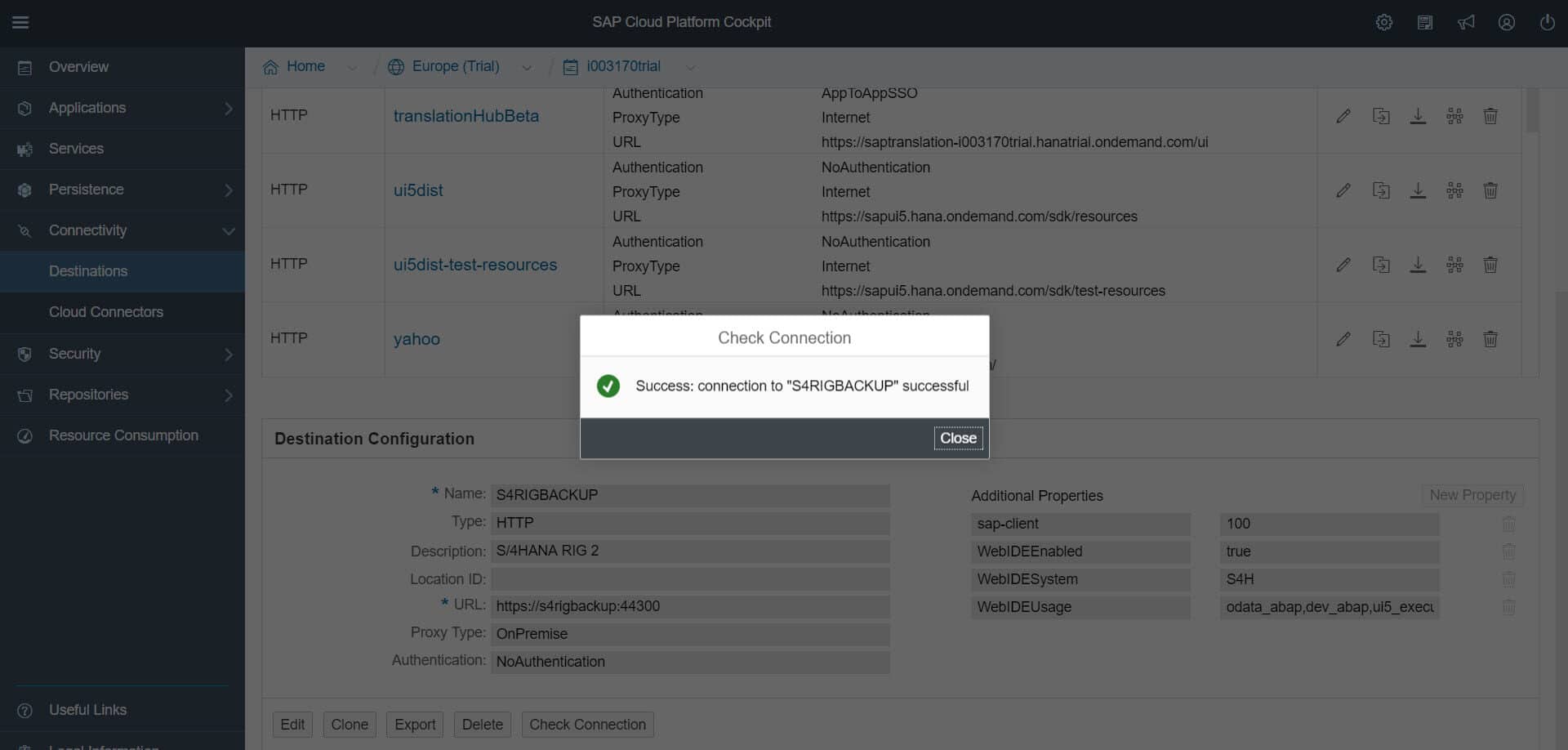
Finding somewhere to practice your S/4HANA and Fiori 2.0 skills can sometimes be a challenge. Fortunately SAP provides a suite of trial options that you can use to get up to speed. To try out the latest techniques in the ABAP Programming Model for Fiori, in Fiori Extensions, and in Fiori element applications, you will need to connect these components so that they work together.
One note of caution: This blog was written using the following versions. Of course you should always check the official documentation for whatever version you are using if you come across any differences.
Examples below are based on:
- Cloud Appliance Library instance created based on the solution “S/4HANA 1610 Fully Activated Appliance” as at April 2017
- SAP Cloud Platform HANA Trial account as at April 2017
- SAP Cloud Connector version 2.9.1
- SAP Web IDE version 170330
Make sure you read through the entire blog before you start! This will save you time as some information you may need to configure or capture when you first set up these instances.
Prerequisites
Your laptop or desktop
We do not yet provide access to the Web IDE on devices.
SAP Cloud Appliance Instance for S/4HANA
A S/4HANA 1610 Trial instance is sufficient
- This is your S/4HANA system itself
- Find out more about the SAP S/4HANA trial & how to get a trial instance from the SAP Cloud Appliance Library

NOTE: SAP Employees should use the internal version of the Cloud Appliance Library at that permits charging to internal account assignment objects. They should use the solution marked as “Golden”.
SAP Cloud Platform account
A free trial account is sufficient
- This provides access to the Web IDE
- Sign up for the free trial account
- Access your free trial account
SAP Cloud Platform Cloud Connector
The Portable version is sufficient. Make sure you have the latest version! (Older versions may not work)
- This connects the CAL instance to the Cloud Platform account in a secure manner, using a VPN tunnel
- You download this from https://tools.hana.ondemand.com/#cloud
- A prerequisite is an appropriate Java Virtual Machine (JVM) which is also explained at https://tools.hana.ondemand.com/#cloud
CAL Instance Specifics
Set up the CAL instance as usual:
- Make sure you have checked the option Open all TCP Ports – this is on by default
- Take note of the IP address assigned to the S/4HANA system (this may be internal or external depending on whether you have created an Intranet or Internet instance) – you can see this in your instance details
- Take note of the client, user, and password needed to access your S/4HANA system as a Developer
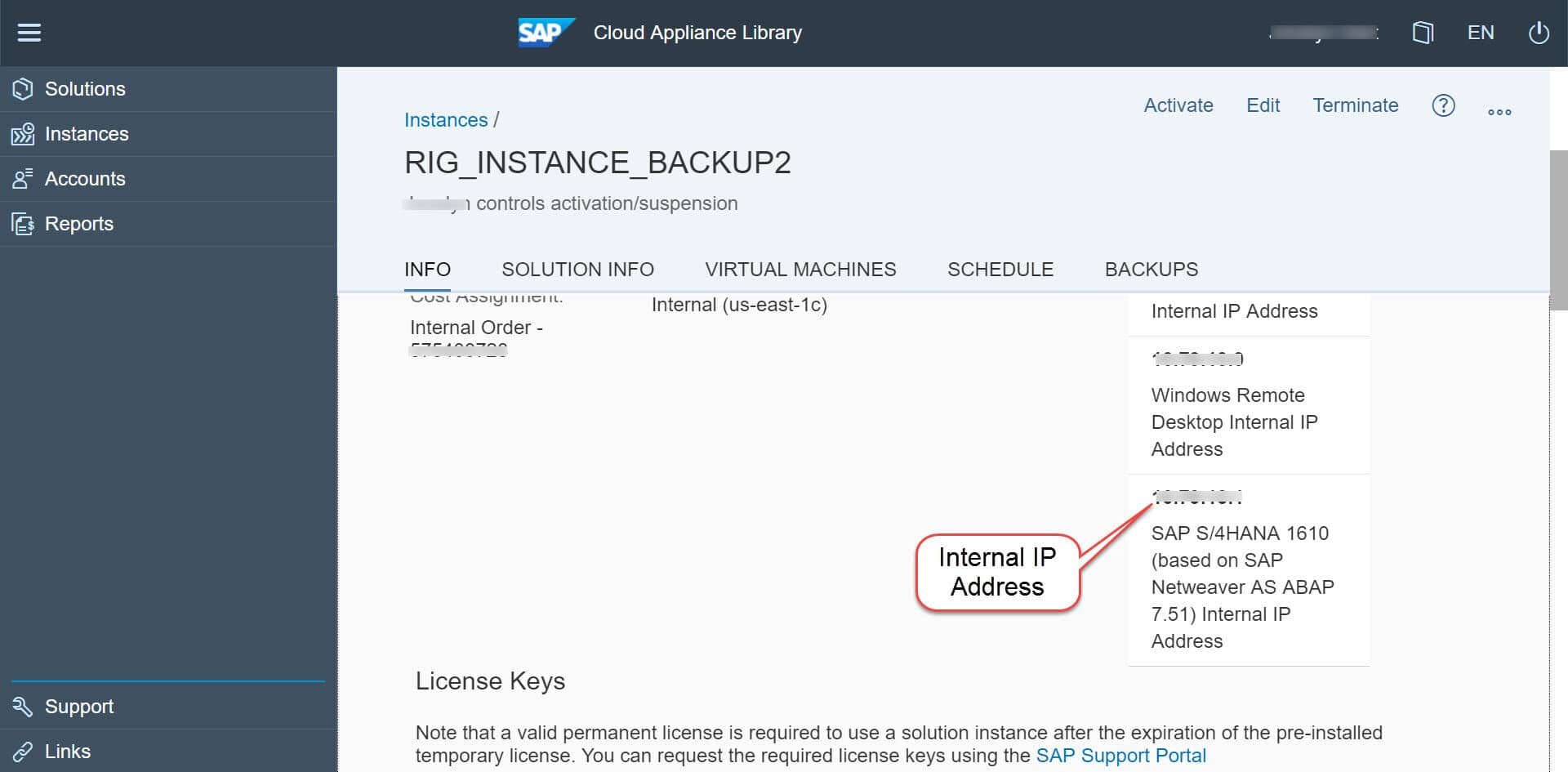
Once your CAL instance is active, make sure you can Connect to it via:
- Remote Desktop
- SAPLogon shortcut
SAP Cloud Platform Specifics
Check you can access the following areas of your account:
- Connectivity > Cloud Connectors
- Connectivity > Destinations
- Services > SAP Web IDE service
Make sure the SAP Web IDE service is enabled. If you are using a trial account this should already be on. In the examples we will use the normal SAP Web IDE service – ignore the innovation version
You will also need:
- Your account id
- Your account user
You find those in the Overview page of your SAP Cloud Platform Cockpit.

You will also need:
- Your account user’s password, i.e. the password you use to login to the Cloud Platform. If you are using the Trial account this will be your SAP Identity password
SAP Cloud Connector Specifics
Install your SAP Cloud Connector as usual.
NOTE: If you are using the Portable edition, make sure you uninstall any old Cloud Connectors before installing the new version, as otherwise the old version may conflict with the new version.
Start your Cloud Connector. If using the Portable version, just run the go.bat file
Launch your Cloud Connector as usual. For example, using your Web Browser and URL https://localhost:8443

Logon as Administrator
Create an entry for your Cloud Platform account as usual.

Check that your account connects successfully to your Cloud Platform.
You can find more information on configuring the Cloud Connector in the Cloud Platform documentation
SAP Cloud Connector Configuration
For the Cloud Platform account you are using, you need to configure Access Control. This defines which resources of your S/4HANA system can be used by your Cloud Platform account.
NOTE: You may configure multiple resources for the same S/4HANA system if needed.
To use the SAP Web IDE, you primarily need to access OData Services in your S/4HANA system. For this you will need to create a Cloud to On-Premise tunnel definition as follows.
Create a mapping for your CAL appliance
Make sure you use the system type ABAP system (do not use SAP Gateway), especially if you are using a S/4HANA trial.
Use the Internal IP address and Port number of your CAL instance.
Optionally you can set a virtual host name and port number that the Cloud Platform will use. A virtual host name can be very useful – e.g. if you need to swap to a different CAL instance you can simply change the internal IP address in the Cloud Connector mapping and continue to use your existing Cloud Platform Destination without making any further changes.
Take care you are using the correct protocol for your S/4HANA system – HTTP or HTTPS – and take a note of this as you will need to create a matching setting in the SAP Cloud Platform Destination later. For the S/4HANA Trial CAL instance, HTTPS protocol is used.
Add the accessible resources as usual.
IMPORTANT: If you are using a trial or sandpit account it’s ok to allow all paths and sub-paths as in the example below. However, If you are using a productive account you must restrict the paths and sub-paths to the minimum that you need. Important paths include:
- /sap/opu/odata & subpaths for OData Services
- /sap/bc/ui5_ui5 & subpaths for executing Fiori(SAPUI5) applications from the SAPUI5 ABAP Repository
- /sap/bc/adt & subpaths for extensibility scenarios, including deploying to the SAPUI5 ABAP Repository

Use the Check Availability icon to to check the S/4HANA system on your CAL instance is reachable.
NOTE: the CAL appliance must currently be ACTIVE for the check to be successful.
Finally go to your Account and check again that it is connected to the Cloud Platform account.
NOTE: If you are using the SAP Cloud Platform trial account and a Portable Cloud Connector, you can only have one system connected at a time – so disable any unwanted services in the Access Control section of your Cloud Connector if you receive an error.
SAP Cloud Platform Configuration
In your SAP Cloud Platform Cockpit, go to option Connectivity > Cloud Connectors
Check your Cloud Connector is shown and your S/4HANA virtual machine & port is Available.
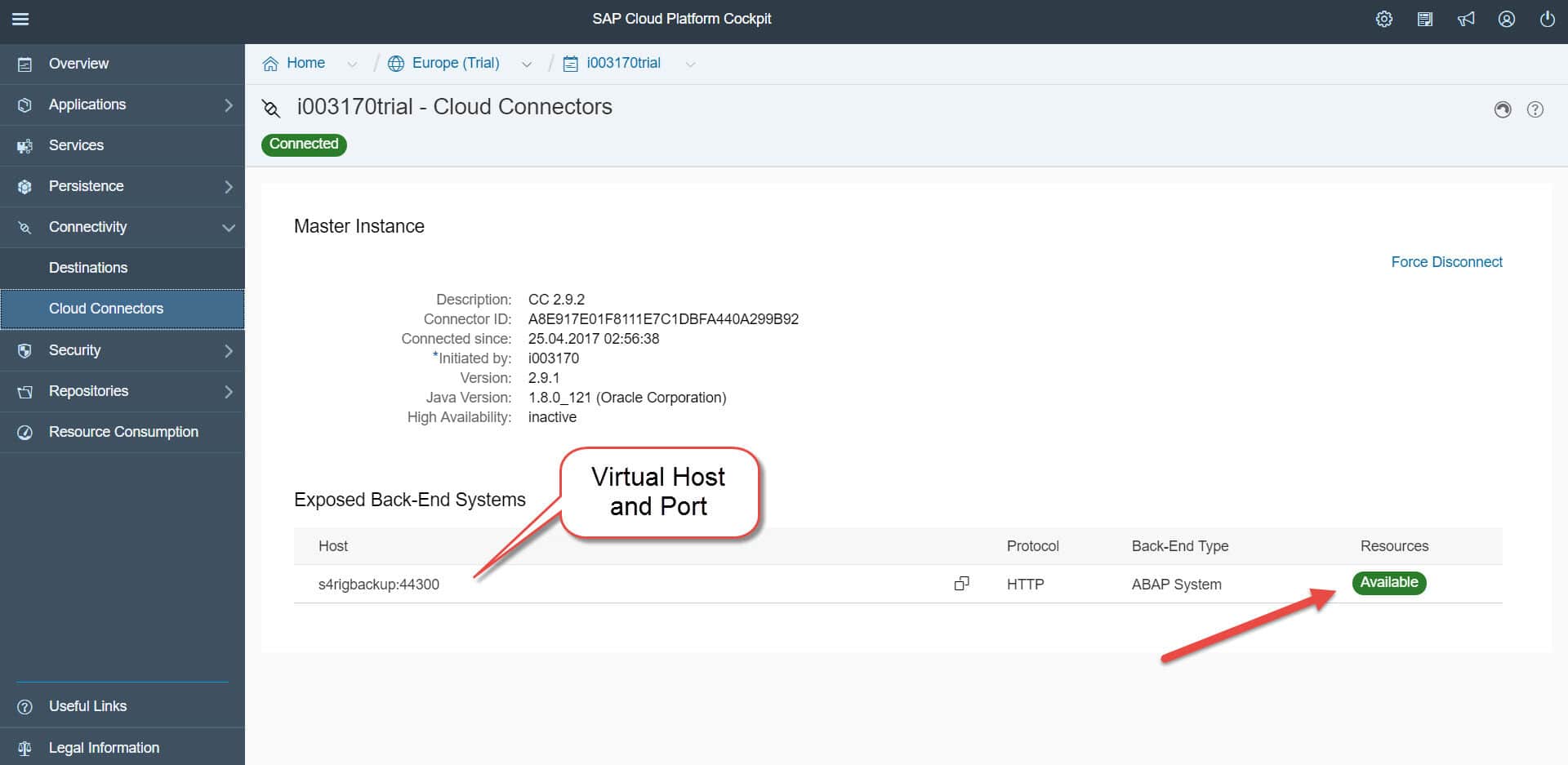
Then go to the option Connectivity > Destinations to create a destination that the Web IDE can use to call your S/4HANA system via the Cloud Connector.
There are a few very important settings:
- The URL must use the Protocol (HTTP or HTTPS), virtual host and port ids exactly as specified in the Cloud Connector
- Make sure you use the NoAuthentication option – this defers authentication until the Web IDE uses the destination explicitly
- Set the proxy type to OnPremise – this indicates the Cloud Connector is used to reach the S/4HANA system
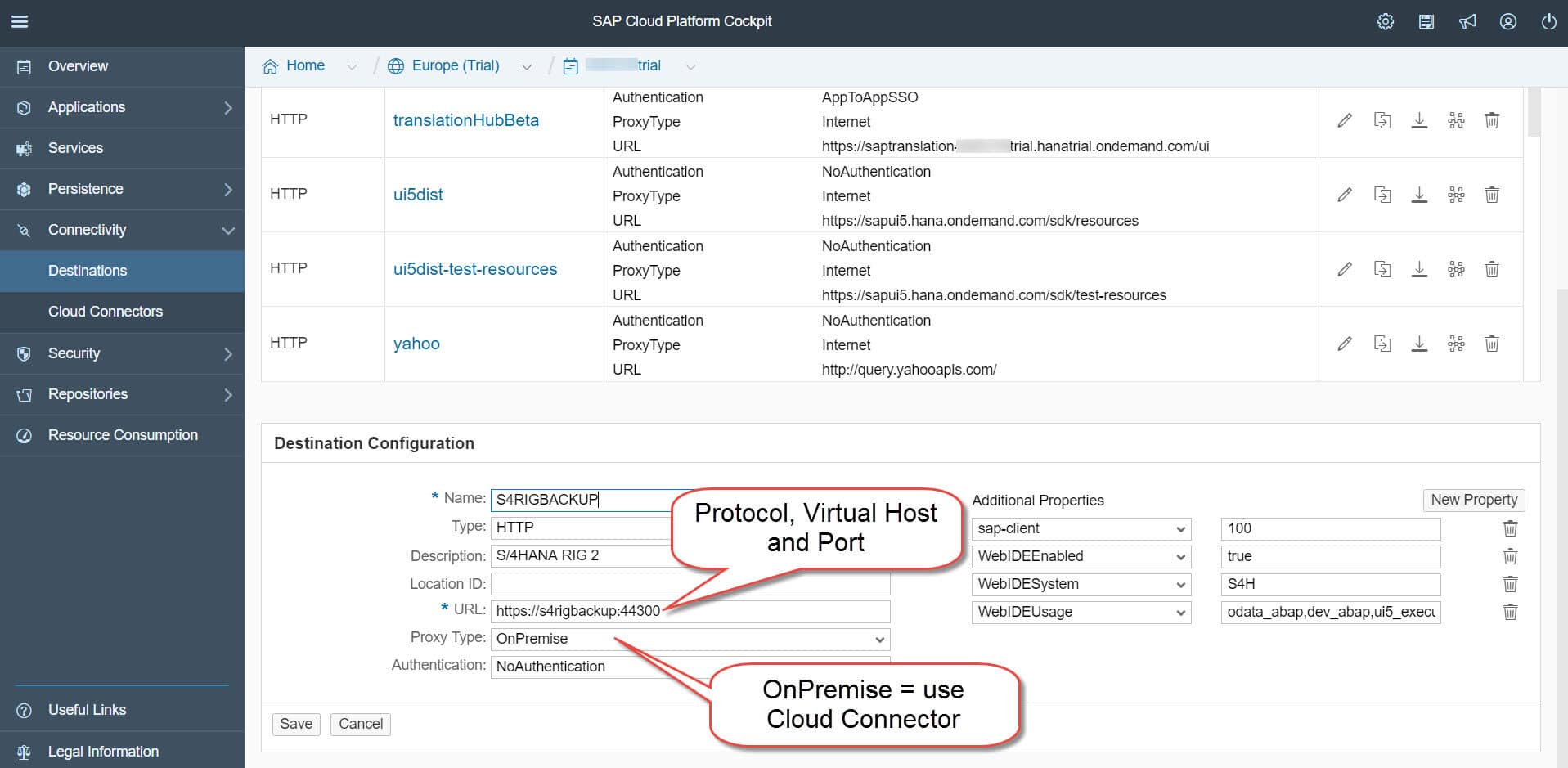
Add the Additional Properties as follows:
- Set sap-client to your S/4HANA client
- Set WebIDEEnabled to true
- Set WebIDESystem to your S/4HANA system id
Set WebIDEUsage to: odata_abap,dev_abap,ui5_execute_abap,bsp_execute_abap
IMPORTANT: Do *not* add odata_gen or smart_business_odata – conflicting odata settings can cause unexpected issues in the Web IDE, e.g. such as the annotation modeller may fail to find odata services
Once you have saved your destination, use the Check Connection button (or Check Availability icon in the Destination list) to check the Destination successfully connects to your S/4HANA system via the Cloud Connector.
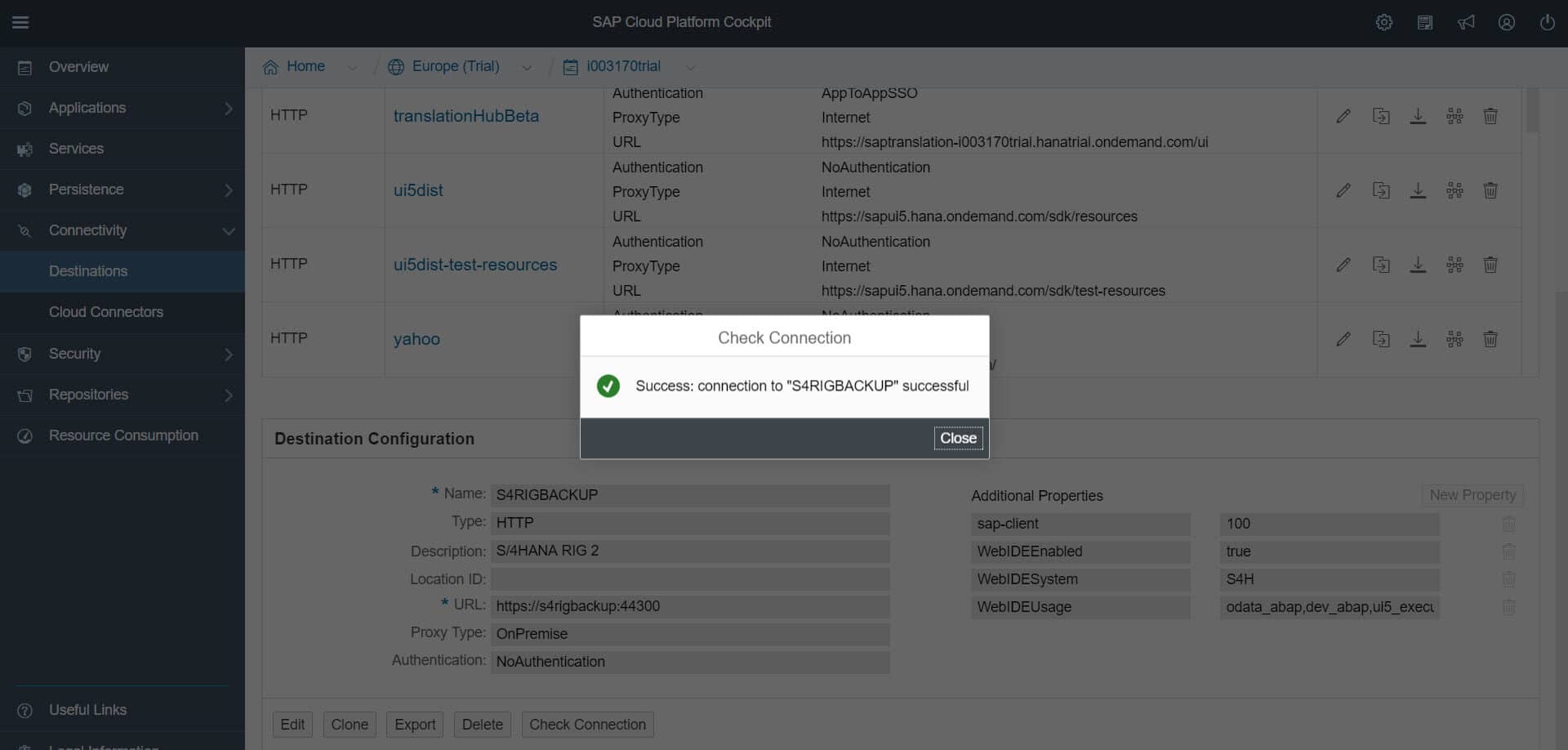
You are now ready to go to the Cloud Platform Cockpit Services option and find the SAP Web IDE service

Enter the SAP Web IDE Service and use the Go to Service link to start the Web IDE
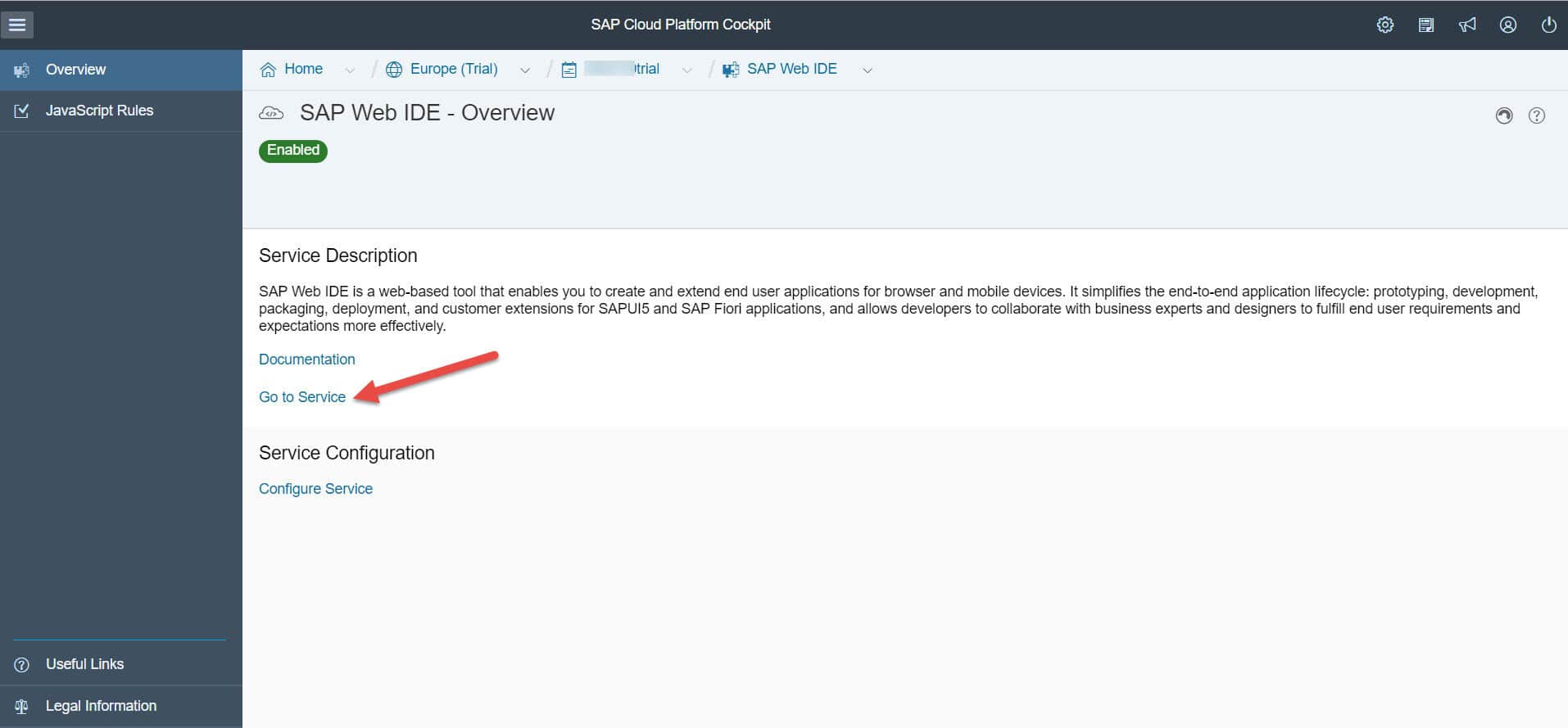
Wait for the SAP Web IDE to load.
Once loaded you can bookmark the SAP Web IDE URL – you do *not* need to enter through the SAP Cloud Platform Cockpit every time.
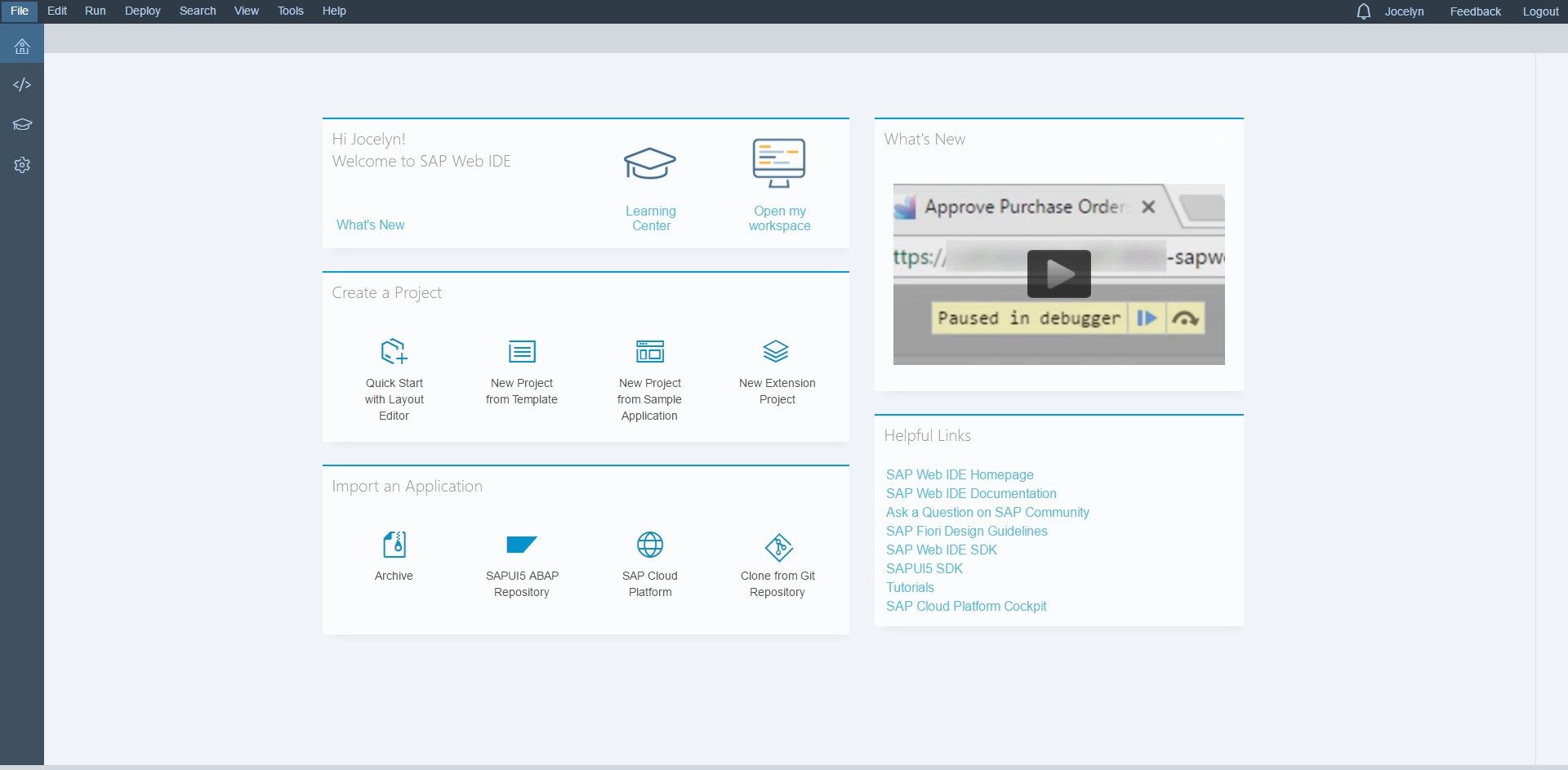
Quick Test in SAP Web IDE to check everything is working correctly
You can quickly test if everything is working correctly by starting one of the wizards.
For example:
Use menu option File > New > Project from Template to start the List Report Application wizard.
Fill in the mandatory fields and move Next to get to the Data Connection step.
Select your SAP Cloud Platform Destination name, and check that the relevant catalog services are listed.
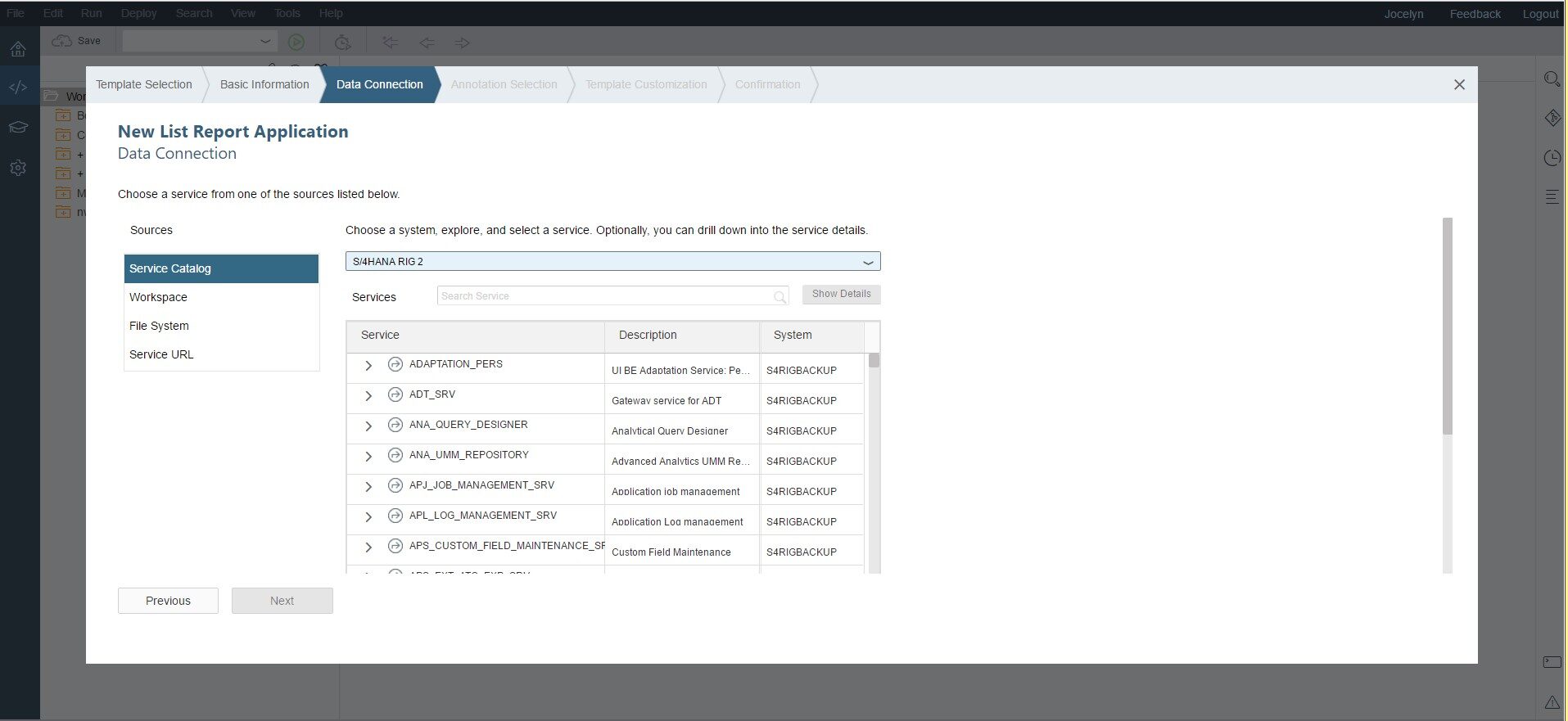
If the services are listed, everything is working and you are ok to continue working in the Web IDE.
Troubleshooting common issues
Catalog service is not available
If you receive an error that the Catalog service is not available, you need to fix this in your S/4HANA system itself.
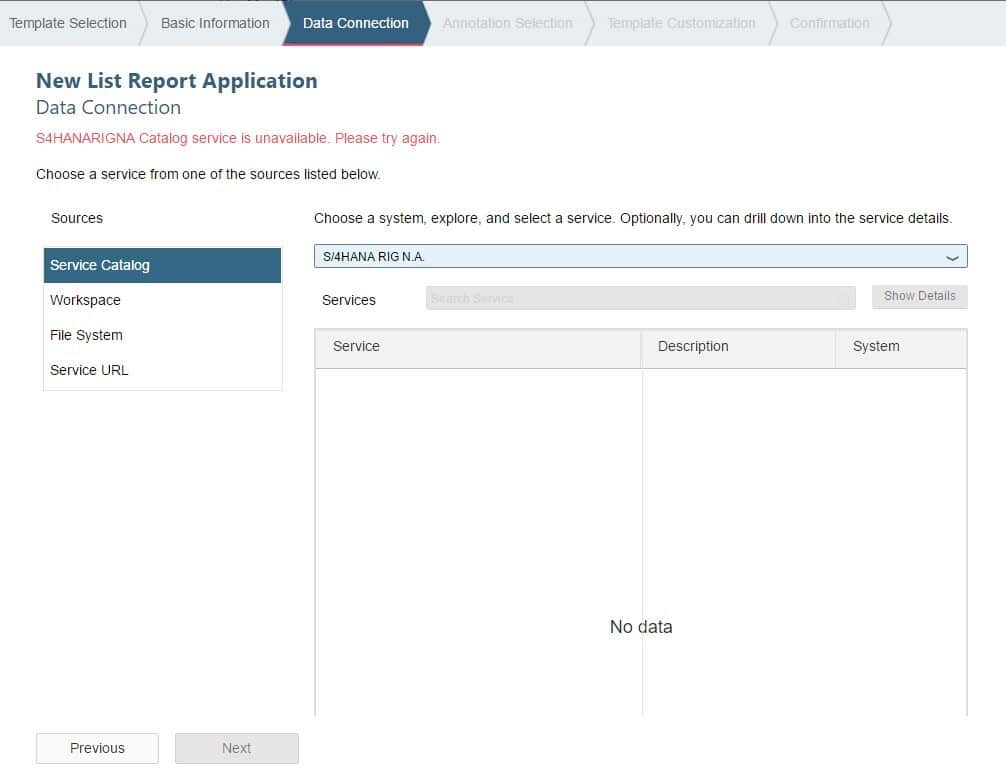
Go to transaction /IWFND/MAINT_SERVICE and find the 2 services for /IWFND/CATALOGSERVICE (CATALOGSERVICE is the External name).
Remove the System Alias for version 1. Make sure the system alias is empty for BOTH version 1 and version 2. Refer to SAP Notes 2372333 and 2402505 for more information.
Annotation file is invalid
When creating Fiori elements you will need to use annotations. If you see a “Annotation file is invalid” error, check that the protocol used in the SAP Cloud Platform Destination URL agrees with whatever was configured in the Cloud Connector.
OData metadata can’t be loaded
When working with Fiori elements it’s very helpful to use the Annotation Modeller tool. If you receive an error “OData metadata can’t be loaded”, check the WebIDEUsage parameter in your SAP Cloud Platform Destination. Only one type of OData usage should be listed.
Connection checks after Suspending and Reactivating your CAL Instance
This is the sequence of checks to run through to make sure everything is ready after you have suspended and reactivated your CAL instance:
CAL instance:
- Check you can login to your S/4HANA system using your Developer user & password
SAP Cloud Platform Cloud Connector:
- Make sure you SAP Cloud Platform Cloud Connector is running.
- Check the S/4HANA system is Reachable
- Check your SAP Cloud Platform Cloud Connector account is connected to the SAP Cloud Platform
SAP Cloud Platform Cockpit:
- Check your Cloud Connector is connected via option Connectivity > Cloud Connector
- Check your Destination connects successfully via your Cloud Connector to your S/4HANA system
- Start the Web IDE service
Troubleshooting
Common problems:
2433274 – Backend is not available in the list of defined system mappings in Cloud connector
2569471 – Error occurs when checking the connection of a destination
2258549 – SAP Cloud Connector fails to connect to the backend
2447136 – Failure reason: “Backend status could not be determined” when checking Destination connection
Otherwise search on the SAP Support launchpad with component BC-NEO-CON
Get Going!
Wishing you all the best in trying the new Fiori 2.0 and S/4HANA techniques!
Need some suggestions? Try these blogs…
Fiori elements – How to Develop a List Report Basic Approach
Fiori elements – How to Develop a List Report using Local Annotations
Developing a Simple List Reporting App (ABAP Programming Model for Fiori)
End to End Fiori In App Extensibility in S/4HANA On Premise
Brought to you by S/4HANA RIG
New NetWeaver Information at SAP.com
Very Helpfull


